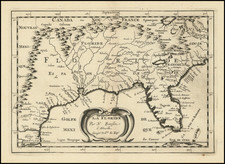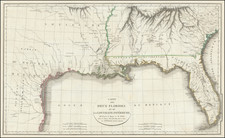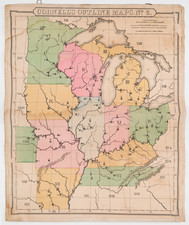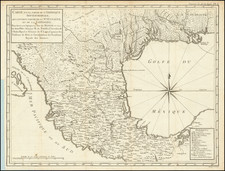Scarce map of the lower Mississippi, Mobile River and Red River, from the English edition of Le Page du Pratz's The History of Louisiana; or of the Western Parts of Virginia and Carolina, published in London in 1763.
Detailed treatment of the region, extending to the Trinity River and the Country of the Quadodaquious in the west and the Mobile River in the East.
Wheat notes that the work is largely "a fanciful tale of transcontinental exploration by an Indian called . . . Moncacht-ape. Du Pratz had been to Louisiana with Bienville and was present at the founding of New Orleans." Du Pratz work affords a great deal of useful information on the Natchez and other Mississippi tribes, which was heavily utilized in later works.
Antoine-Simon Le Page du Pratz (1695-1775), was an ethnographer, historian, and naturalist who is best known for his Histoire de la Louisiane. It was first published in installments from 1751-1753 in the Journal Economique, then completely in three volumes in Paris in 1758. AnEnglish published it in translation in 1763. The memoir was based on Le Page's years in Louisiana from 1718 to 1734. On May 25, 1718 he left La Rochelle, France, with 800 men on one of three ships bound for Louisiana. He arrived on August 25, 1718. Le Page lived in Louisiana from 1718 to 1734, and from 1720 to 1728 at Natchez, Mississippi. His companion was a Chitimacha woman (and likely had children with her), learned the Natchez language, and befriended local native leaders.
When he finally wrote his memoir, Le Page directly used the words of many of his Native informants, rather than describing the "manners and customs of the Indians" in the detached fashion of so many colonial authors. Because of his own interest in the origins of Native Americas, Le Page was especially attentive to the account by the Yazoo explorer Moncacht-apé. Moncacht-ape was purported to have traveled to the Pacific coast and back, a century before the Lewis & Clark Expedition.
While modern scholars question the veracity of the Moncacht-ape account, Lewis & Clark carried a copy of the English edition with them on their Expedition to the Pacific Ocean.











![(Southern Travel Journal) [Manuscript travel journal to Mobile, Alabama by Andrew Clark, Jr. of Methuen, Massachusetts, also by horseback through Kentucky and Tennessee and up the Mississippi north to Pittsburgh]](https://storage.googleapis.com/raremaps/img/small/93034.jpg)


